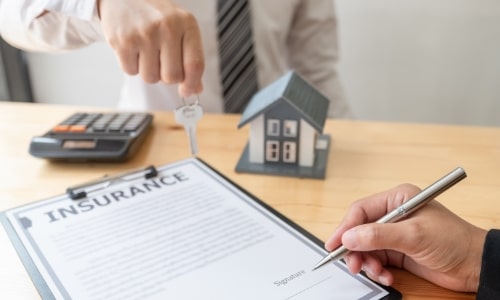800 800 001
Home Insurance Underwriting in the UAE: A Comprehensive Guide
When you apply for home insurance, you're not just picking a plan—you're entering a process where the insurance company carefully checks the risks involved in covering your home. This step is called home insurance underwriting. It is the method insurers use to decide if they can offer you coverage, ...read more
Introduction to Home Insurance Underwriting
The term underwriting in insurance refers to the systematic evaluation of risks before issuing an insurance policy.
Specifically, home insurance underwriting focuses on assessing potential hazards that could lead to property damage or loss. The primary objective is to ascertain the likelihood of a claim being made and set premiums that accurately reflect the associated risk.
Best Home Insurance in UAE
Some of the best and the cheapest Home insurance quotes in Dubai are:
Home Insurance Underwriting Process in UAE
Getting a home policy involves a detailed evaluation process known as the home insurance underwriting process. This procedure assesses the risk associated with insuring a property and determines the appropriate coverage terms and premiums.
Home insurance underwriting process in the UAE is guided by regulations set forth by the Central Bank of the UAE (CBUAE) for a standardised and fair approach across the insurance sector.
Key Steps in the Home Insurance Underwriting Process
-
Application Submission
- Information Gathering: Homeowners begin by submitting an application that includes comprehensive details about the property such as its location, size, construction materials, age, and installed safety features (if any)
-
Risk Assessment
- Property Evaluation: Underwriters analyse the provided information to identify potential risks. Factors affecting home insurance underwriting include the property's susceptibility to natural disasters, proximity to high-risk areas, and overall structural integrity.
- Security Measures: The presence of security systems, fire alarms, and other safety installations can positively influence the risk assessment, potentially leading to more favourable premium rates.
-
Due Diligence
- Verification: Insurers may conduct on-site inspections or request additional documentation to verify the accuracy of the information provided.
- Financial Evaluation: An assessment of the homeowner's financial stability and claims history may also be performed to gauge the likelihood of future claims.
-
Policy Determination
- Coverage Terms: Based on the risk assessment, home insurance underwriters establish the terms and conditions of the insurance policy, including coverage limits and exclusions.
- Premium Calculation: The premium is calculated by aligning the level of risk with the insurer's pricing models so that it reflects the specific risk profile of the property.
-
Approval and Issuance
- Decision Making: Once the home insurance underwriting process is complete, the insurer decides whether to approve the application. If approved, the policy is issued with the agreed-upon terms and premiums.
- Policy Documentation: The homeowner receives the policy documents, which detail the coverage, terms, conditions, and procedures for filing claims.
Factors Influencing Home Insurance Underwriting in the UAE
The home insurance underwriting process impacts the coverage terms and premium rates offered to homeowners. Several critical factors influence this process —
- Property Location: The geographical location of a property plays a crucial role in home insurance underwriting UAE. Homes situated in areas prone to natural disasters, such as floods, or regions with elevated crime rates are perceived as higher risk. Consequently, these properties may attract higher premiums due to the increased likelihood of claims.
- Construction Materials and Property Age: The materials used in constructing a home, along with your home’s age, significantly affect the home insurance underwriting process.
Properties built with fire-resistant materials like concrete or stone are deemed safer and may benefit from lower premiums. Conversely, older homes with outdated electrical or plumbing systems might pose higher risks, leading to increased insurance costs.
- Security Measures: Implementing security systems, including burglar alarms, CCTV cameras, and fire alarms, can positively influence home insurance underwriting UAE. Such measures reduce the risk of theft and damage, making the property less susceptible to claims and potentially lowering premium rates.
- Claims History: A homeowner's past insurance claims (if any) are scrutinised during the home insurance underwriting process. A history of frequent claims may indicate a higher risk, which prompts insurers to set higher premiums or impose specific coverage limitations. Maintaining a clean claims record can be advantageous in securing favourable insurance terms.
- Coverage Amount and Deductibles: The chosen coverage limits and deductible amounts directly impact the premium calculations in the home insurance underwriting process. Opting for higher coverage limits increases the insurer's potential payout, leading to higher premiums. Conversely, selecting higher deductibles can lower premium costs, although this may require you to bear a greater portion of any claim.
Role of Home Insurance Underwriters
When you apply for a home insurance policy in the UAE, a professional known as a home insurance underwriter plays a crucial role in determining the specifics of your coverage. Let's explore their key responsibilities —
1.) Risk Assessment:
The primary duty of an underwriter is to evaluate the potential risks associated with insuring your property. By considering these elements, the underwriter determines the likelihood of future claims.
2.) Determining Coverage Terms and Premiums
Based on the risk assessment, the home insurance underwriter decides —
- Coverage Limits: The maximum amount the insurance company will pay in the event of a claim
- Premium Amount: The cost that you, as the homeowner, will pay for the insurance policy
The goal is to set fair and accurate premiums that reflect the true risk of insuring the property, i.e. homeowners pay an amount corresponding to their level of risk.
3.) Policy Compliance and Documentation:
Underwriters confirm that each policy complies with UAE insurance regulations and company guidelines. They meticulously document —
- Policy Details: Specific terms, conditions, and any exclusions
- Risk Evaluations: Notes on how conclusions about risk were reached
4.) Ongoing Risk Management
Even after a policy is issued, home insurance underwriters may —
- Review Claims: Analyse any claims made to identify patterns or emerging risks
- Adjust Policies: Recommend changes to coverage or premiums based on new information or changes to the property
Frequently Asked Questions
Insurance underwriting is the process that insurers use to evaluate the risk of insuring a person or asset. It is also used to determine the terms and pricing of the insurance coverage.
To start the home insurance underwriting process, you need to submit —
- Emirates ID and proof of residency
- Proof of property ownership or tenancy contract
- Recent utility bill (for address verification)
- Floor plan or property layout (if requested)
- Details of installed safety/security systems
Yes! In fact, tenants are often encouraged to get contents insurance to protect their belongings. The underwriting in insurance for rented properties focuses on the value and type of contents, occupancy status, and tenant behaviour rather than structural risks (which are usually the landlord’s responsibility).
Absolutely yes. If you upgrade your kitchen, install solar panels, or renovate a bathroom, you must inform your insurer. These changes may alter the risk profile, increase the property's value, or improve safety — impacting the home insurance underwriting process and potentially your premiums.
Yes, it can. If the home insurance underwriter identifies high-risk factors — frequent past claims, non-compliant construction, or lack of safety features — your application might be declined or returned with conditions (e.g., higher deductibles, partial coverage). Always provide accurate and full information to minimise rejection risks.
Most cases related to home insurance underwriting UAE are completed within 1–3 working days. However, if additional inspections or documents are required, it could take up to a week. Fast responses and complete documents can speed up approval.
Yes! After the home insurance underwriter reviews your details, you can often adjust deductibles, include add-on coverages (like valuables or tenant liabilities), or improve home safety to reduce premiums.
Home Insurance Popular Searches
Home Insurance Dubai | Content Insurance Dubai | Building Insurance | Best Home Insurance in UAE | Holiday Home Insurance | Types of Properties in UAE | Compare Home Insurance | Home Emergency Insurance | Does Home Insurance Cover Fire Damage | Tenant Insurance | Does Home Insurance Cover Lost Jewellery
Other Insurance Products
Business Insurance Dubai, Group Medical Insurance, Public Liability Insurance, Marine Insurance, Professional Indemnity Insurance, Worker's Compensation Insurance, SME Business Insurance, Group Life Insurance UAE, Contractors All Risk Insurance, Product Liability Insurance, Directors and Officers insurance, Motor Fleet Insurance, Medical Malpractice Insurance, Health Insurance
More From Home Insurance
- Recent Articles
- Popular Articles



















